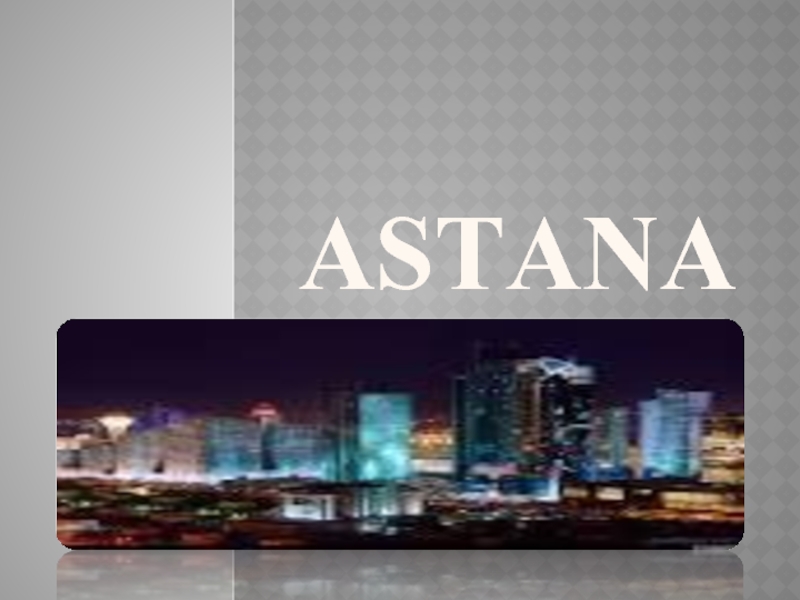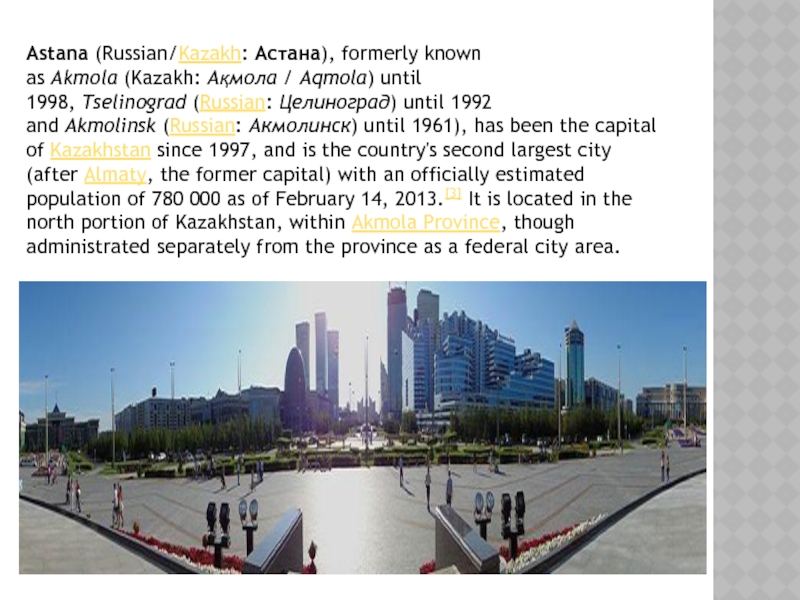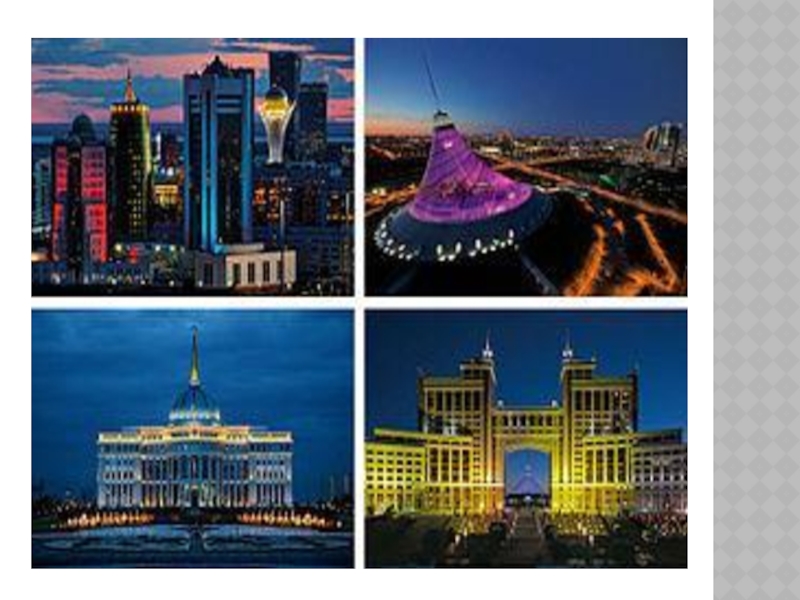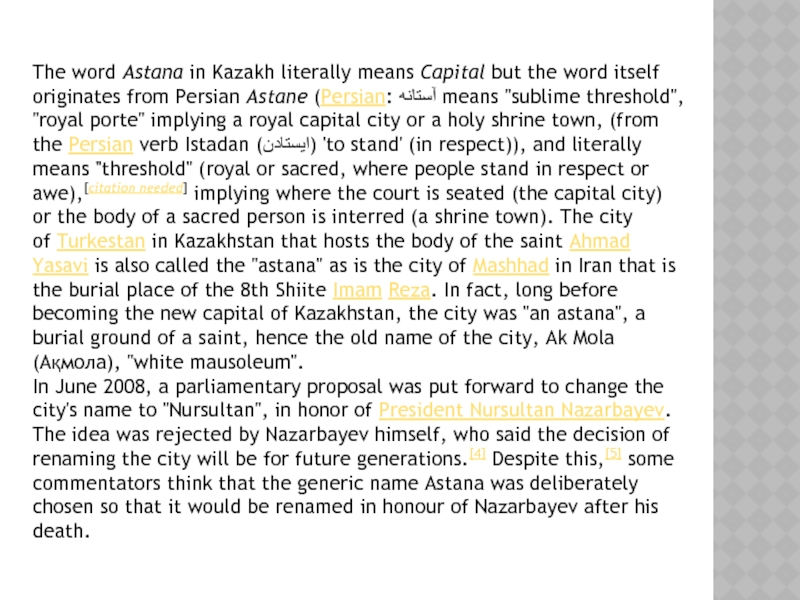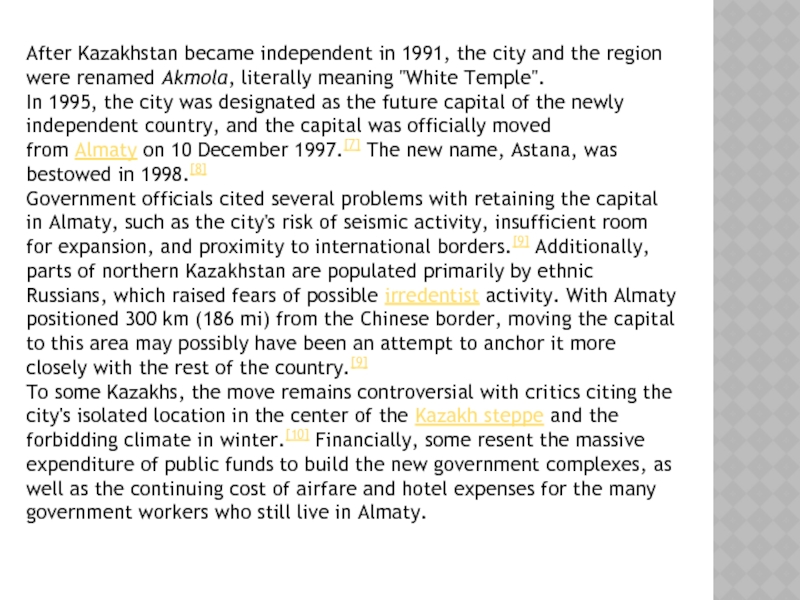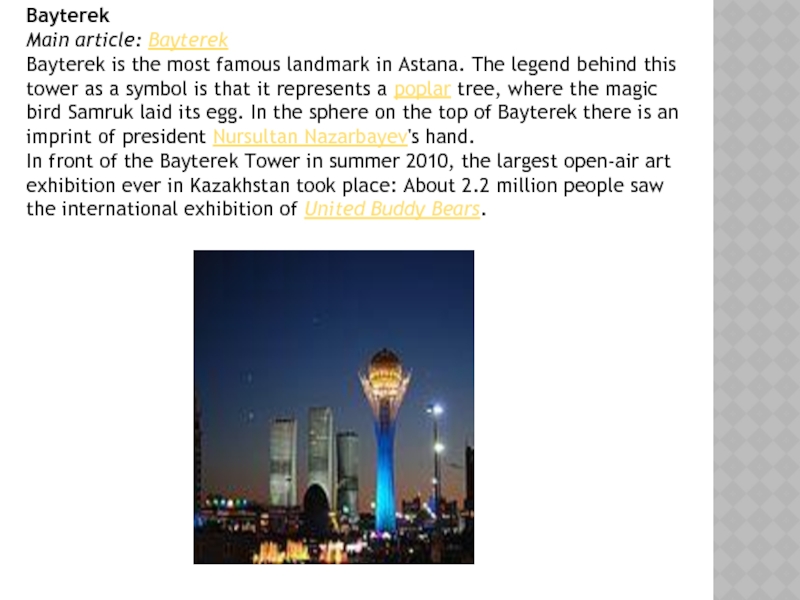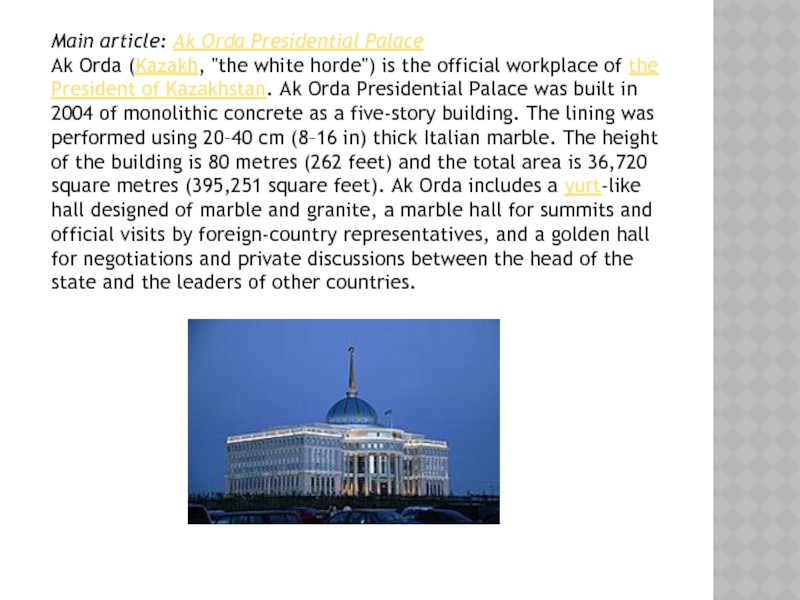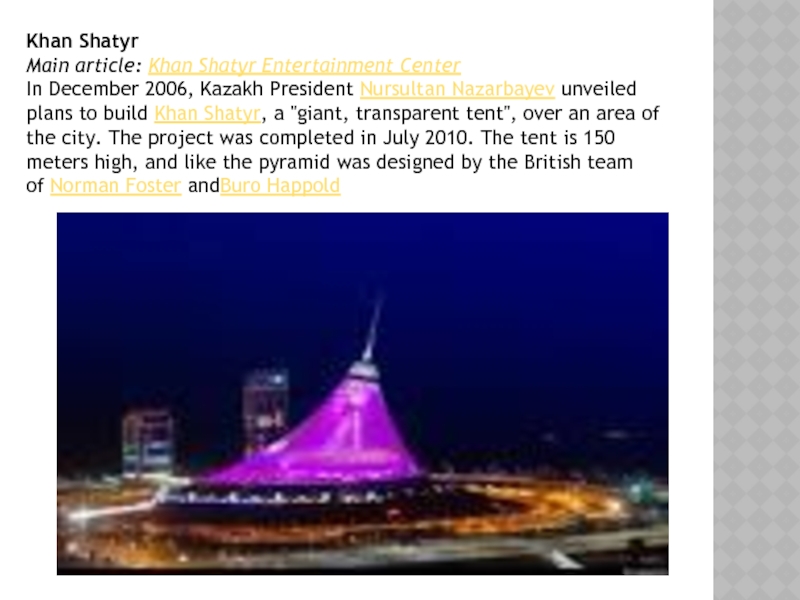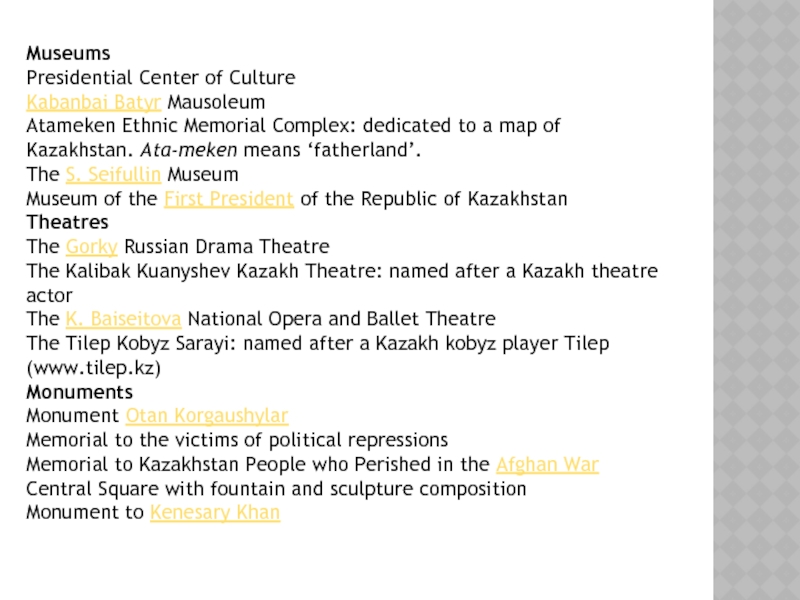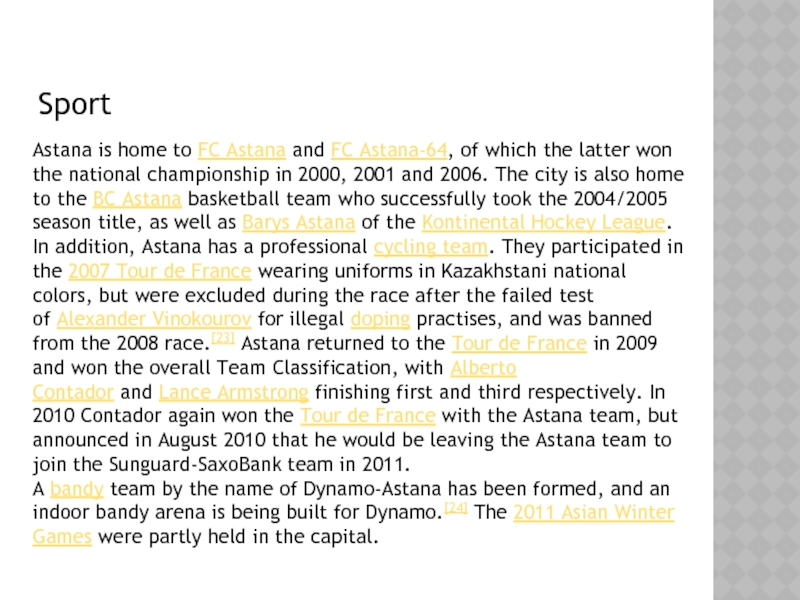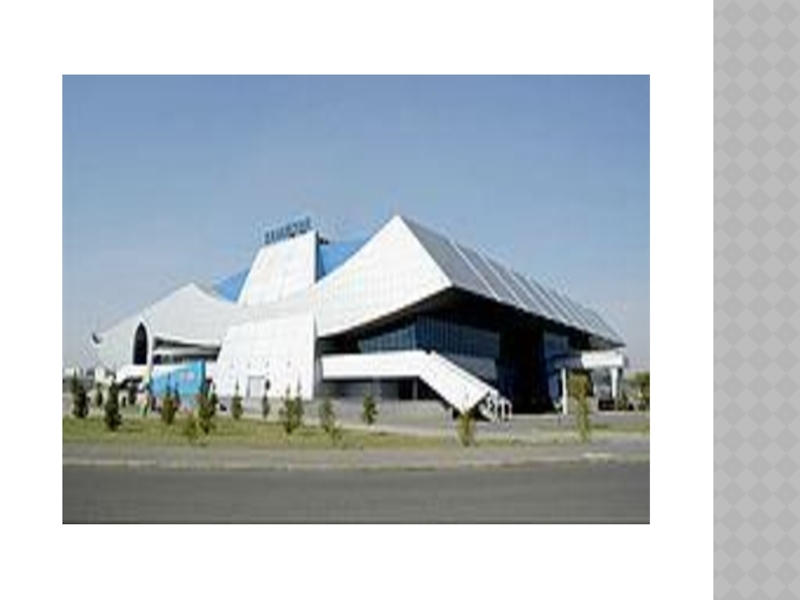- Главная
- Разное
- Дизайн
- Бизнес и предпринимательство
- Аналитика
- Образование
- Развлечения
- Красота и здоровье
- Финансы
- Государство
- Путешествия
- Спорт
- Недвижимость
- Армия
- Графика
- Культурология
- Еда и кулинария
- Лингвистика
- Английский язык
- Астрономия
- Алгебра
- Биология
- География
- Детские презентации
- Информатика
- История
- Литература
- Маркетинг
- Математика
- Медицина
- Менеджмент
- Музыка
- МХК
- Немецкий язык
- ОБЖ
- Обществознание
- Окружающий мир
- Педагогика
- Русский язык
- Технология
- Физика
- Философия
- Химия
- Шаблоны, картинки для презентаций
- Экология
- Экономика
- Юриспруденция
The capital of Kazakhstan Astana презентация
Содержание
- 1. The capital of Kazakhstan Astana
- 2. Astana (Russian/Kazakh: Астана), formerly known as Akmola (Kazakh: Ақмола / Aqmola) until 1998, Tselinograd (Russian: Целиноград) until
- 4. The word Astana in Kazakh literally means Capital but the word
- 5. After Kazakhstan became independent in 1991, the
- 6. Town planning Astana can be divided largely
- 7. Bayterek Main article: Bayterek Bayterek is the most
- 8. Main article: Ak Orda Presidential Palace Ak Orda
- 9. Khan Shatyr Main article: Khan Shatyr Entertainment Center
- 10. Museums Presidential Center of Culture Kabanbai Batyr Mausoleum
Слайд 2Astana (Russian/Kazakh: Астана), formerly known as Akmola (Kazakh: Ақмола / Aqmola) until 1998, Tselinograd (Russian: Целиноград) until 1992 and Akmolinsk (Russian: Акмолинск) until 1961),
has been the capital of Kazakhstan since 1997, and is the country's second largest city (after Almaty, the former capital) with an officially estimated population of 780 000 as of February 14, 2013.[3] It is located in the north portion of Kazakhstan, within Akmola Province, though administrated separately from the province as a federal city area.
Слайд 4The word Astana in Kazakh literally means Capital but the word itself originates from Persian Astane (Persian: آستانه
means "sublime threshold", "royal porte" implying a royal capital city or a holy shrine town, (from the Persian verb Istadan (ایستادن) 'to stand' (in respect)), and literally means "threshold" (royal or sacred, where people stand in respect or awe),[citation needed] implying where the court is seated (the capital city) or the body of a sacred person is interred (a shrine town). The city of Turkestan in Kazakhstan that hosts the body of the saint Ahmad Yasavi is also called the "astana" as is the city of Mashhad in Iran that is the burial place of the 8th Shiite Imam Reza. In fact, long before becoming the new capital of Kazakhstan, the city was "an astana", a burial ground of a saint, hence the old name of the city, Ak Mola (Ақмола), "white mausoleum".
In June 2008, a parliamentary proposal was put forward to change the city's name to "Nursultan", in honor of President Nursultan Nazarbayev. The idea was rejected by Nazarbayev himself, who said the decision of renaming the city will be for future generations.[4] Despite this,[5] some commentators think that the generic name Astana was deliberately chosen so that it would be renamed in honour of Nazarbayev after his death.
In June 2008, a parliamentary proposal was put forward to change the city's name to "Nursultan", in honor of President Nursultan Nazarbayev. The idea was rejected by Nazarbayev himself, who said the decision of renaming the city will be for future generations.[4] Despite this,[5] some commentators think that the generic name Astana was deliberately chosen so that it would be renamed in honour of Nazarbayev after his death.
Слайд 5After Kazakhstan became independent in 1991, the city and the region
were renamed Akmola, literally meaning "White Temple".
In 1995, the city was designated as the future capital of the newly independent country, and the capital was officially moved from Almaty on 10 December 1997.[7] The new name, Astana, was bestowed in 1998.[8]
Government officials cited several problems with retaining the capital in Almaty, such as the city's risk of seismic activity, insufficient room for expansion, and proximity to international borders.[9] Additionally, parts of northern Kazakhstan are populated primarily by ethnic Russians, which raised fears of possible irredentist activity. With Almaty positioned 300 km (186 mi) from the Chinese border, moving the capital to this area may possibly have been an attempt to anchor it more closely with the rest of the country.[9]
To some Kazakhs, the move remains controversial with critics citing the city's isolated location in the center of the Kazakh steppe and the forbidding climate in winter.[10] Financially, some resent the massive expenditure of public funds to build the new government complexes, as well as the continuing cost of airfare and hotel expenses for the many government workers who still live in Almaty.
In 1995, the city was designated as the future capital of the newly independent country, and the capital was officially moved from Almaty on 10 December 1997.[7] The new name, Astana, was bestowed in 1998.[8]
Government officials cited several problems with retaining the capital in Almaty, such as the city's risk of seismic activity, insufficient room for expansion, and proximity to international borders.[9] Additionally, parts of northern Kazakhstan are populated primarily by ethnic Russians, which raised fears of possible irredentist activity. With Almaty positioned 300 km (186 mi) from the Chinese border, moving the capital to this area may possibly have been an attempt to anchor it more closely with the rest of the country.[9]
To some Kazakhs, the move remains controversial with critics citing the city's isolated location in the center of the Kazakh steppe and the forbidding climate in winter.[10] Financially, some resent the massive expenditure of public funds to build the new government complexes, as well as the continuing cost of airfare and hotel expenses for the many government workers who still live in Almaty.
Слайд 6Town planning
Astana can be divided largely into a few different areas.
Almaty"
District
District was created on 6 May 1998 by the Decree of the President of the Republic of Kazakhstan Territory of "Almaty" District is 21,054 hectares (52 025 acres or 81.290 sq.miles). Population - 321.400 people. The district has five villages. Yesil" District
District was created on 5 Aug 2008 by the Decree of the President of the Republic of Kazakhstan. It occupies the territory of 31,179 hectares (77 045 acres or 120.382 sq.miles) Population - approx. 180,000 people.
"Saryarka" District
District was created on 6 May 1998 by the Decree of the President of the Republic of Kazakhstan The territory of "Saryarka" district is 19,202 hectares (47 449 acres or 74.139 sq.miles). Population - 296,364 people.
Description[
North of the railway line, which crosses Astana in an east-west direction, are industrial and poorer residential areas. Between the railway line and the river Ishim is the city center, where at present intense building activity is occurring. To the west and east are more elevated residential areas with parks and the new area of government administration to the south of the Ishim. Here many large building projects are underway; for example, the construction of a diplomatic quarter, and a variety of different government buildings. By 2030, these quarters are to be completed. The original plans for the new Astana were drawn up by the late Japanese architect Kisho Kurokawa. Astana's current chief planner, Vladimir Laptev, wants to build a Berlin in aEurasian style. He has stated that a purely administrative capital such as Canberra is not one of his goals.
Hilton, Astana
Architecture
The old buildings that remained from the Soviet era are now being removed and replaced with totally new structures resulting in significant construction work throughout the city. President Nazarbayev has paid particular attention to Astana's architecture; most of the recently completed structures had been accredited to internationally acclaimed architects and designers such as Kisho Kurokawa or Norman Foster.
District was created on 6 May 1998 by the Decree of the President of the Republic of Kazakhstan Territory of "Almaty" District is 21,054 hectares (52 025 acres or 81.290 sq.miles). Population - 321.400 people. The district has five villages. Yesil" District
District was created on 5 Aug 2008 by the Decree of the President of the Republic of Kazakhstan. It occupies the territory of 31,179 hectares (77 045 acres or 120.382 sq.miles) Population - approx. 180,000 people.
"Saryarka" District
District was created on 6 May 1998 by the Decree of the President of the Republic of Kazakhstan The territory of "Saryarka" district is 19,202 hectares (47 449 acres or 74.139 sq.miles). Population - 296,364 people.
Description[
North of the railway line, which crosses Astana in an east-west direction, are industrial and poorer residential areas. Between the railway line and the river Ishim is the city center, where at present intense building activity is occurring. To the west and east are more elevated residential areas with parks and the new area of government administration to the south of the Ishim. Here many large building projects are underway; for example, the construction of a diplomatic quarter, and a variety of different government buildings. By 2030, these quarters are to be completed. The original plans for the new Astana were drawn up by the late Japanese architect Kisho Kurokawa. Astana's current chief planner, Vladimir Laptev, wants to build a Berlin in aEurasian style. He has stated that a purely administrative capital such as Canberra is not one of his goals.
Hilton, Astana
Architecture
The old buildings that remained from the Soviet era are now being removed and replaced with totally new structures resulting in significant construction work throughout the city. President Nazarbayev has paid particular attention to Astana's architecture; most of the recently completed structures had been accredited to internationally acclaimed architects and designers such as Kisho Kurokawa or Norman Foster.
Слайд 7Bayterek
Main article: Bayterek
Bayterek is the most famous landmark in Astana. The legend
behind this tower as a symbol is that it represents a poplar tree, where the magic bird Samruk laid its egg. In the sphere on the top of Bayterek there is an imprint of president Nursultan Nazarbayev's hand.
In front of the Bayterek Tower in summer 2010, the largest open-air art exhibition ever in Kazakhstan took place: About 2.2 million people saw the international exhibition of United Buddy Bears.
In front of the Bayterek Tower in summer 2010, the largest open-air art exhibition ever in Kazakhstan took place: About 2.2 million people saw the international exhibition of United Buddy Bears.
Слайд 8Main article: Ak Orda Presidential Palace
Ak Orda (Kazakh, "the white horde") is
the official workplace of the President of Kazakhstan. Ak Orda Presidential Palace was built in 2004 of monolithic concrete as a five-story building. The lining was performed using 20–40 cm (8–16 in) thick Italian marble. The height of the building is 80 metres (262 feet) and the total area is 36,720 square metres (395,251 square feet). Ak Orda includes a yurt-like hall designed of marble and granite, a marble hall for summits and official visits by foreign-country representatives, and a golden hall for negotiations and private discussions between the head of the state and the leaders of other countries.
Слайд 9Khan Shatyr
Main article: Khan Shatyr Entertainment Center
In December 2006, Kazakh President Nursultan Nazarbayev unveiled
plans to build Khan Shatyr, a "giant, transparent tent", over an area of the city. The project was completed in July 2010. The tent is 150 meters high, and like the pyramid was designed by the British team of Norman Foster andBuro Happold
Слайд 10Museums
Presidential Center of Culture
Kabanbai Batyr Mausoleum
Atameken Ethnic Memorial Complex: dedicated to a
map of Kazakhstan. Ata-meken means ‘fatherland’.
The S. Seifullin Museum
Museum of the First President of the Republic of Kazakhstan
Theatres
The Gorky Russian Drama Theatre
The Kalibak Kuanyshev Kazakh Theatre: named after a Kazakh theatre actor
The K. Baiseitova National Opera and Ballet Theatre
The Tilep Kobyz Sarayi: named after a Kazakh kobyz player Tilep (www.tilep.kz)
Monuments
Monument Otan Korgaushylar
Memorial to the victims of political repressions
Memorial to Kazakhstan People who Perished in the Afghan War
Central Square with fountain and sculpture composition
Monument to Kenesary Khan
The S. Seifullin Museum
Museum of the First President of the Republic of Kazakhstan
Theatres
The Gorky Russian Drama Theatre
The Kalibak Kuanyshev Kazakh Theatre: named after a Kazakh theatre actor
The K. Baiseitova National Opera and Ballet Theatre
The Tilep Kobyz Sarayi: named after a Kazakh kobyz player Tilep (www.tilep.kz)
Monuments
Monument Otan Korgaushylar
Memorial to the victims of political repressions
Memorial to Kazakhstan People who Perished in the Afghan War
Central Square with fountain and sculpture composition
Monument to Kenesary Khan
Слайд 11
Astana is home to FC Astana and FC Astana-64, of which the latter won the national championship in 2000, 2001 and 2006. The city is also home to the BC Astana basketball team who successfully took the 2004/2005 season title, as well as Barys Astana of the Kontinental Hockey League. In addition, Astana has a professional cycling team. They participated in the 2007 Tour de France wearing uniforms in Kazakhstani national colors, but were excluded during the race after the failed test of Alexander Vinokourov for illegal doping practises, and was banned from the 2008 race.[23] Astana returned to the Tour de France in 2009 and won the overall Team Classification, with Alberto Contador and Lance Armstrong finishing first and third respectively. In 2010 Contador again won the Tour de France with the Astana team, but announced in August 2010 that he would be leaving the Astana team to join the Sunguard-SaxoBank team in 2011.
A bandy team by the name of Dynamo-Astana has been formed, and an indoor bandy arena is being built for Dynamo.[24] The 2011 Asian Winter Games were partly held in the capital.
Sport
